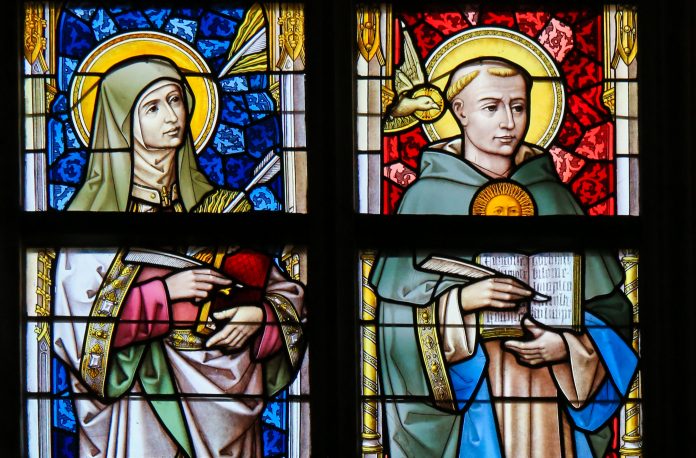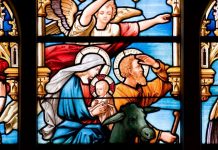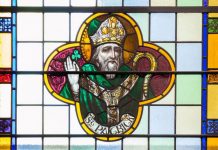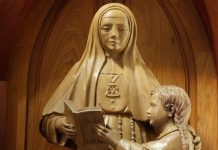
by D. D. Emmons
Saints are found in every part of Catholic life. If we lose something we invoke St. Anthony. If life seems impossible we seek out St. Rita. We ask St. Peregrine to help those with cancer. We look to St. Christopher to protect us when we travel. Some saints had errant pasts, like St. Paul and St. Augustine. Others, in the manner of John Vianney, spent their entire lives humbly doing God’s will.
Such holy people have lived in every time and every culture. But what is a saint and how did Catholics get so attached to them?
Greeting Saints
Saints have been identified in Church history since at least the time of the Apostle Paul. From about 54 to 63 A.D., Paul used the word saint or holy ones (from the Latin sanctus) in his New Testament letters to the Christians at Corinth, Ephesus, Philippe, Colossae, and Rome.
For example, Paul wrote to the Philippians, “To all the holy ones in Christ Jesus who are in Philippi, with the overseers and ministers” (1:1). He ends the letter, “Give my greetings to every holy one in Christ Jesus. The brothers who are with me send their greetings; all the holy ones send you their greetings, especially those of Caesar’s household” (4:21-22).
Paul used the words saints and holy ones to describe those who, through Baptism, had converted to Christianity, received the sanctifying grace of God, and were seeking to earnestly follow the teachings of Jesus.
The Risk of Saintliness
Choosing to become a disciple of Christ during Paul’s lifetime—or anytime in the first 300 years after Christ’s Resurrection—was risky. The first Christians were converts from Judaism and were often considered outcasts or troublemakers by their fellow Jews. The Roman Empire dominated most of the world in those early centuries and, while the central government in Rome tolerated many Jewish traditions, Christians were labeled as enemies of the state because of their total allegiance to the “One crucified.”
Early Christians rejected every Roman rule not in harmony with Christ’s teachings—including refusing to pay homage to pagan gods and to the alleged divine status of the emperor. As a result, Christians were confronted and arrested by the occupying Romans. Those incarcerated who publicly denied Christ were released; those refusing would be charged with treason and sentenced to years in prison, torture, even death.
Christians who willingly sacrificed themselves rather than reject Jesus became known as martyrs (from the Greek word martyria, meaning a “witness”). Martyrs were regarded as heroes—the most courageous and purest followers of Christ who, by their sacrifice, secured a place in heaven. Other devout Christians, also willing to face death for their fidelity to Christ but who somehow escaped persecution, were honored in the manner of the martyrs.
These pious individuals were all remembered through special ceremonies and prayers on the anniversary of their deaths. The stories of their love of Christ have been handed down through the centuries and we Catholics still honor them.
Saints by Popular Acclaim
In the fourth century, Emperor Constantine ended the persecution of Christ’s followers. Christianity began to expand and included large numbers of converts from countries made up of pagans and uncivilized peoples. These converts were generally uneducated, had little religious knowledge, and were less scrupulous about their new faith than other Christians.
Thus the need to identify Christian role models—to publicly recognize those believers who lived lives of steadfast Christian virtue—became increasingly important.
Over the next few centuries, many people were declared saints simply by popular acclaim. That is, if a person was perceived to have piously followed the way of Christ, was well known to the community, and was compassionate and charitable, he or she, upon death, could be publicly proclaimed and treated as a saint by the local populace.
At that time, there was no universal Church rule on matters such as selecting saints. Consequently, every town had its own saints or holy ones and each saint was given significant attention by the locals. Sometimes all commerce stopped on the day designated to remember the saint. The saint’s name would be included in the liturgy and he or she might be remembered with the erection of statues, shrines, stained-glass windows, and pilgrimages to pray wherever the saint was honored.
The belief then as now was that these holy people are spending eternity with Jesus and can intercede on behalf of the living.
The Communion of Saints
The bond between living Christians and those in eternity became known as the Communion of Saints. This belief remains deeply rooted in Catholic faith.
The Church teaches that our affinity for the saints and their virtuous lives does not distract us from Almighty God but, in fact, draws us closer. The document of the Second Vatican Council titled Lumen Gentium (Dogmatic Constitution on the Church) reads: “…let the faithful be taught that our communion with these in heaven, provided that it is understood in the full light of faith, in no way diminishes the worship of adoration given to God the Father, through Christ, in the Spirit; on the contrary, it greatly enriches it” (n. 51).
In the late tenth century, John XV became the first pope to oversee the choosing of people for sainthood. However, it was 1588 before the Vatican issued detailed selection criteria for use throughout the universal Church.
Models and Intercessors
At present, the number of known saints exceeds 10,000, but only about a third of that number has been selected by the Church process called canonization. This is the process by which the pope declares someone who lived a life of holy sanctity as venerable, then blessed, and finally a saint. Each of these steps involves a lengthy and exhausting examination of the individual under consideration.
“By canonizing some of the faithful, i.e., by solemnly proclaiming that they practiced heroic virtue and lived in fidelity to God’s grace, the Church recognizes the power of the Spirit of holiness within her and sustains the hope of believers by proposing the saints to them as models and intercessors” (Catechism of the Catholic Church, n. 828, emphasis in original).
Why Saints Today
The names of saints and examples of their holiness are described in our missals, in Catholic print media, in the Breviary, and in church bulletins. Each saint, recognized as such by the Church, is assigned a feast day on which we can publicly commemorate his or her birth into heaven.
Catholic churches are routinely named in honor of a saint, and a relic of the patron often is buried inside the church altar. We conduct public and private devotions including novenas to these holy people; we light candles in their honor; we take their names at Confirmation; and we study their sanctity and God-given wisdom.
As models of faith, they give us hope that we, too, can achieve eternity with Our Lord Jesus Christ.
D .D. Emmons writes from O’Fallon. IL.
Copyright 2011, Bayard, Inc. All rights reserved. This article is protected by United States copyright and other intellectual property laws and may not be reproduced, rewritten, distributed, redisseminated, transmitted, displayed, published or broadcast, directly or indirectly, in any medium without the prior written permission of Bayard, Inc.
This article was written by the Catechist Staff and appeared in Catechist magazine, March 2011.
Image Credit: jorisvo/Shutter Stock 544541167




